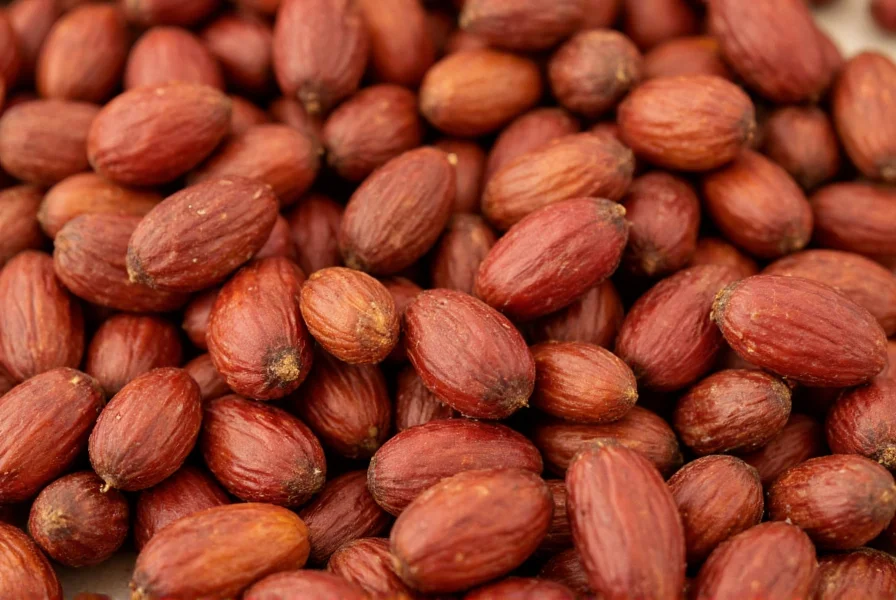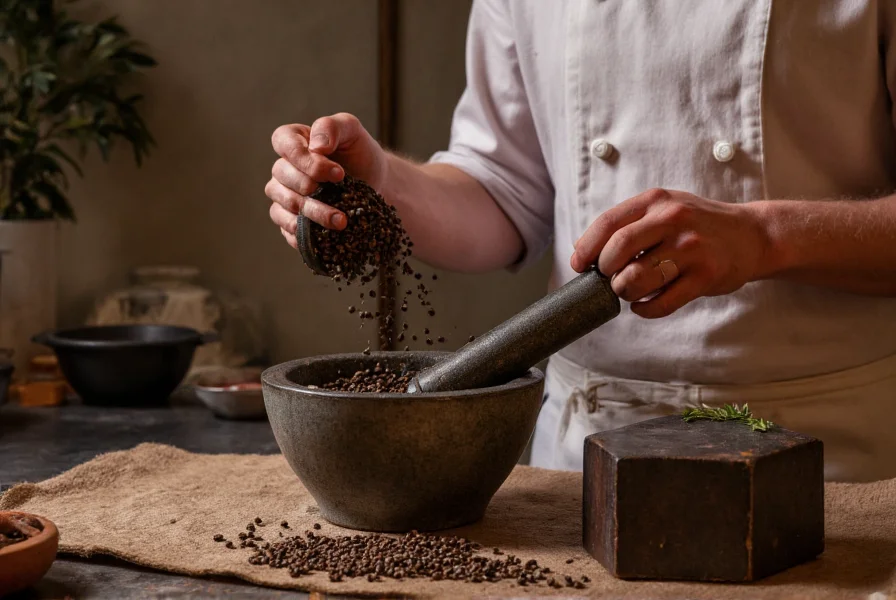Native to the coastal regions of West Africa, particularly Ghana and Nigeria, this aromatic spice has been traded along ancient routes for centuries. Its scientific name is Aframomum melegueta, and it's sometimes mistakenly called "African black pepper" or "alligator pepper," though these terms can refer to different but related spices.
Understanding Cameroon Pepper's Unique Characteristics
Cameroon pepper consists of small, reddish-brown seeds enclosed in pods. When dried, these seeds develop their distinctive complex flavor profile that sets them apart from other peppercorns. The spice contains aromatic compounds including gingerols (also found in ginger), shogaols, and paradols, which contribute to its warming sensation without the intense heat of chili peppers.
Unlike standard black pepper (Piper nigrum), which delivers a straightforward pungent heat, Cameroon pepper offers a more nuanced experience. Its flavor evolves on the palate, beginning with citrus notes, developing warm spice characteristics, and finishing with a subtle peppery kick. This complexity makes it valuable for both traditional African dishes and contemporary fusion cuisine.
Historical Significance and Cultural Context
Historically known as "grains of paradise" in European markets during the Middle Ages, this spice was once so valuable it was used as currency. European explorers sought it along West African trade routes, particularly along the Grain Coast (modern-day Liberia), which earned its name from this valuable commodity.
In West African culinary traditions, Cameroon pepper features prominently in soups, stews, and meat preparations. It's often used in combination with other local spices to create complex flavor bases. Traditional medicinal applications across various African cultures have included using the spice for digestive issues and as a warming remedy during cold seasons, though modern scientific research on these applications remains limited.
| Characteristic | Cameroon Pepper | Black Pepper | Grains of Paradise |
|---|---|---|---|
| Botanical Family | Zingiberaceae | Piperaceae | Zingiberaceae |
| Primary Flavor Notes | Citrus, floral, warm spice | Sharp, pungent | Lemon, cardamom, pepper |
| Heat Level | Moderate (3-4/10) | Moderate (5-6/10) | Low-Moderate (2-3/10) |
| Common Culinary Uses | West African stews, spice blends | Global seasoning | Nordic baking, craft beverages |
Culinary Applications and Pairing Suggestions
Chefs worldwide are rediscovering Cameroon pepper for its versatility. When using this spice, consider these applications:
- Meat preparations: Excellent with game meats, poultry, and fish due to its citrus notes that cut through richness
- Vegetable dishes: Complements roasted root vegetables, particularly carrots and sweet potatoes
- Beverage infusions: Adds complexity to craft cocktails, spiced wines, and non-alcoholic beverages
- Baking applications: Works well in gingerbread, spice cakes, and other warm-spice desserts
- Spice blends: Forms the base of many West African suya spice mixtures and can enhance curry powders
For best flavor extraction, lightly toast whole seeds before grinding. Unlike black pepper which is often added at the end of cooking, Cameroon pepper benefits from being introduced earlier in the cooking process to allow its complex flavors to meld with other ingredients.
Health Considerations and Scientific Research
Traditional African medicine has utilized Cameroon pepper for various purposes, including digestive support and as a warming remedy. Modern research suggests potential benefits related to its bioactive compounds:
Studies indicate that Aframomum melegueta contains antioxidants and compounds with potential anti-inflammatory properties. Research published in the Journal of Ethnopharmacology has examined its traditional uses, though more comprehensive clinical studies are needed to confirm specific health benefits. As with any spice, consumption in culinary amounts is generally considered safe, but therapeutic use should be discussed with healthcare providers.
Selecting and Storing Authentic Cameroon Pepper
When purchasing Cameroon pepper, look for these quality indicators:
- Fragrant aroma with citrus and floral notes
- Deep reddish-brown color (avoid dull or faded specimens)
- Whole seeds rather than pre-ground powder for maximum freshness
- Reputable spice merchants specializing in African ingredients
Store in an airtight container away from light and heat. Whole seeds maintain their potency for 1-2 years, while ground spice loses flavor within 3-6 months. For extended storage, consider keeping in the freezer.
Simple Recipe Incorporating Cameroon Pepper
Here's an approachable way to experience Cameroon pepper in your cooking:
West African Spiced Roasted Chicken
- 4 chicken thighs, bone-in
- 2 teaspoons ground Cameroon pepper
- 1 teaspoon smoked paprika
- 1 teaspoon garlic powder
- 1/2 teaspoon ground ginger
- 2 tablespoons olive oil
- 1 tablespoon lemon juice
- Salt to taste
Mix spices with olive oil and lemon juice. Rub mixture onto chicken and refrigerate for at least 2 hours. Roast at 400°F (200°C) for 35-40 minutes until internal temperature reaches 165°F (74°C). The Cameroon pepper creates a complex crust with warm, citrusy notes that complement the chicken beautifully.

Common Misconceptions About Cameroon Pepper
Several misunderstandings persist about this spice:
- It's just another name for black pepper - While both are called "pepper," they come from different botanical families with distinct flavor profiles
- All "grains of paradise" are the same - The term sometimes refers to different but related species with subtle flavor variations
- It's extremely hot - While it has warmth, it's significantly milder than chili peppers and comparable to black pepper in heat level
- It's only for African cuisine - Its versatility makes it suitable for global applications from Scandinavian baking to modern fusion dishes
Understanding these distinctions helps cooks use Cameroon pepper more effectively in various culinary contexts rather than treating it as a simple black pepper substitute.

Where Cameroon Pepper Fits in Modern Culinary Trends
As global cuisine continues to evolve, Cameroon pepper has found new relevance beyond its traditional applications. Contemporary chefs value it for several reasons:
- Its complex flavor profile aligns with the growing interest in nuanced, layered tastes rather than单一 dominant flavors
- As a non-chili heat source, it appeals to those seeking warming spices without intense burn
- Its historical significance connects to the increasing focus on culinary heritage and authentic ingredient sourcing
- Chefs exploring "new world" spice combinations find it bridges European, African, and American flavor traditions
When experimenting with Cameroon pepper, start with small amounts (1/4 to 1/2 teaspoon per dish) to appreciate its subtle complexity without overwhelming other flavors. As your palate becomes familiar with its characteristics, you'll discover how this ancient spice can elevate both traditional and innovative recipes.
What's the difference between Cameroon pepper and grains of paradise?
Cameroon pepper and grains of paradise refer to the same spice (Aframomum melegueta). The different names stem from historical trade routes - "grains of paradise" was the term used in medieval Europe, while "Cameroon pepper" reflects its West African origin. Some regional variations exist in how the terms are used, but they generally describe the same botanical species.
Can I substitute Cameroon pepper in recipes calling for black pepper?
Yes, but with adjustments. Cameroon pepper has a more complex flavor profile with citrus and floral notes, so use about 25-30% less than black pepper when substituting. It works particularly well in recipes where you want additional flavor dimensions beyond simple heat. For dishes relying on black pepper's sharp pungency, consider using a 50/50 blend of both peppers.
Is Cameroon pepper safe for people with pepper allergies?
Individuals with allergies to black pepper (Piper nigrum) may tolerate Cameroon pepper since it comes from a different botanical family (Zingiberaceae vs. Piperaceae). However, allergic reactions can vary, and those with severe pepper allergies should consult an allergist before trying Cameroon pepper. Always introduce new spices cautiously if you have known food sensitivities.
How does Cameroon pepper compare to pink peppercorns?
While both have reddish hues, Cameroon pepper and pink peppercorns are completely different. Pink peppercorns come from a cashew-family plant (Schinus molle) and have a fruity, resinous flavor with mild heat. Cameroon pepper offers warmer, more complex notes with citrus and cardamom undertones. They're not direct substitutes, though both can add interesting dimensions to dishes when used appropriately.
What traditional West African dishes feature Cameroon pepper prominently?
Cameroon pepper is essential in several West African specialties including Nigerian pepper soup, Ghanaian light soup, and various stews across the region. It's particularly important in suya (spiced grilled meat) seasoning blends, where it combines with other spices like ginger, cloves, and chili peppers. The spice also features in traditional palm wine preparations and certain ceremonial food preparations throughout the region.











 浙公网安备
33010002000092号
浙公网安备
33010002000092号 浙B2-20120091-4
浙B2-20120091-4